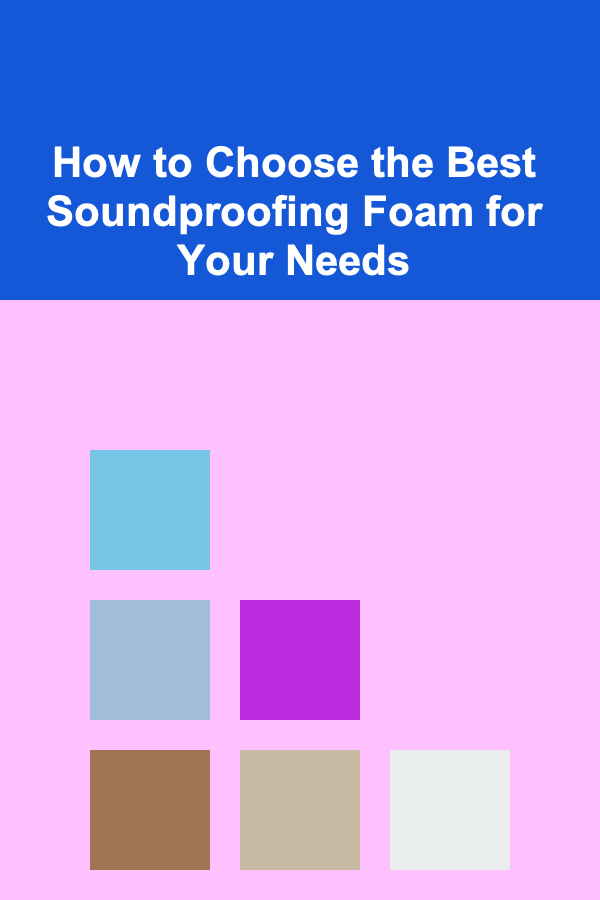
How to Choose the Best Soundproofing Foam for Your Needs
ebook include PDF & Audio bundle (Micro Guide)
$12.99$8.99
Limited Time Offer! Order within the next:

In a world where noise pollution is becoming increasingly prevalent, soundproofing your environment can make a significant difference in your quality of life. Whether you're a musician looking to create a home studio, a podcaster aiming for clear audio, or simply someone who wishes to reduce outside noise intrusion, soundproofing foam can be an effective solution. This guide will explore the various types of soundproofing foam, their applications, and how to choose the best option for your specific needs.
Understanding Soundproofing Foam
Before diving into specific products, it's essential to understand what soundproofing foam is and how it works.
1. What is Soundproofing Foam?
Soundproofing foam refers to specialized materials designed to absorb sound waves and reduce noise transmission between spaces. Unlike traditional insulation, which primarily focuses on thermal insulation, soundproofing foam targets acoustic properties to minimize echoes and improve overall sound quality.
2. Types of Acoustic Treatment
There are two main categories of acoustic treatment that involve foam:
- Absorption: This type helps to reduce reverberation and echo within a room by absorbing sound waves.
- Blocking: While soundproofing foam mainly focuses on absorption, some products can also contribute to blocking sound transmission when layered appropriately.
3. Benefits of Using Soundproofing Foam
Using soundproofing foam offers several advantages:
- Improved Sound Quality: By reducing echoes and unwanted sounds, you can achieve clearer audio recordings, making it ideal for studios and broadcasting.
- Enhanced Privacy: Soundproofing foam can help keep conversations private by minimizing sound leakage.
- Comfort: Reducing noise levels contributes to a more peaceful living or working environment.
Types of Soundproofing Foam
When selecting soundproofing foam, it's crucial to understand the different types available and their specific characteristics.
1. Acoustic Foam Panels
a. Design and Structure
Acoustic foam panels are typically made from polyurethane or melamine foam and come in various shapes, including wedges, pyramids, and egg crates. The surface structure is designed to trap sound waves and reduce reflection.
b. Applications
These panels are best suited for:
- Home recording studios
- Podcasting rooms
- Home theaters
- Offices
c. Performance
Acoustic foam panels are effective for mid to high-frequency sound absorption but may not significantly block low frequencies. Therefore, they work best in combination with other soundproofing methods.
2. Bass Traps
a. Design and Structure
Bass traps are thicker foam panels specifically designed to absorb low-frequency sounds. They are usually placed in corners where low-frequency sound tends to accumulate.
b. Applications
Bass traps are essential for:
- Recording studios
- Music practice rooms
- Home theaters
c. Performance
These traps excel at managing low-frequency issues, improving overall sound clarity in any space where bass-heavy music or sounds are produced.
3. Soundproofing Blankets
a. Design and Structure
Soundproofing blankets are typically made from dense materials and may feature sound-absorbing foam layers. They can be hung over walls, doors, or windows to reduce noise transmission.
b. Applications
These blankets are suitable for:
- Temporary soundproofing solutions
- Apartment dwellers
- Areas with limited space for permanent installations
c. Performance
While they do not absorb sound as effectively as foam panels, they can provide decent noise reduction for areas where soundproofing needs to be adjusted regularly.
4. Open-Cell vs. Closed-Cell Foam
a. Open-Cell Foam
Open-cell foam features interconnected cells, allowing air and moisture to pass through. This type is great for sound absorption but has lower density, which means it will not block sound as effectively.
- Applications: Ideal for indoor environments and applications focused on acoustics.
b. Closed-Cell Foam
Closed-cell foam consists of tightly packed cells, making it denser and more effective at blocking sound. This type is often used in environments where sound isolation is crucial.
- Applications: Suitable for outdoor use and high-performance soundproofing situations.
Factors to Consider When Choosing Soundproofing Foam
Selecting the right soundproofing foam requires careful consideration of several factors.
1. Purpose of Use
Understanding your primary purpose for using soundproofing foam is critical:
- Recording: If you need to record audio, focus on acoustic foam panels that reduce echo and improve sound quality.
- Noise Reduction: For general noise reduction in living spaces, consider bass traps and soundproofing blankets.
2. Room Characteristics
The characteristics of the room where you plan to install the foam will influence your choices:
a. Room Size
Larger rooms may require additional foam to effectively manage sound. Consider the following guidelines:
- Small Rooms: Fewer panels can adequately treat smaller spaces.
- Large Rooms: More extensive coverage will be necessary; layering different types of foam can help.
b. Room Shape
Irregularly shaped rooms can create unique sound challenges. In such cases:
- Acoustic Panels: Position them strategically at reflection points.
- Bass Traps: Place them in corners where low frequencies tend to build up.
3. Sound Frequency Needs
Different types of soundproofing foam cater to varying frequency ranges:
- High Frequencies: Acoustic foam panels are excellent for mid to high-frequency absorption.
- Low Frequencies: For bass management, opt for bass traps and thicker foam products.
4. Aesthetic Considerations
Soundproofing foam comes in various colors and designs. If aesthetics are important:
- Choose Colors: Pick shades that complement your existing decor.
- Customization: Some manufacturers offer custom-cut panels to fit your design preferences.
5. Installation Methods
Consider how you want to install the soundproofing foam:
- Permanent Installations: Adhesive sprays or mounting hardware may work for long-term setups.
- Temporary Solutions: Look for removable adhesive options or hanging solutions for flexibility.
6. Budget
Your budget will impact the type and quantity of foam you can afford. Here are some tips:
- Cost of Materials: Acoustic foam panels can range in price depending on thickness, density, and manufacturer.
- Balancing Quality and Cost: Opt for reputable brands known for effective soundproofing, even if they are slightly more costly.
Measuring and Planning for Foam Installation
Once you've decided on the type of foam that suits your needs, the next step is measuring and planning for installation.
1. Assess Coverage Area
Determine the total square footage of the area you wish to cover with soundproofing foam:
- Measure wall dimensions, keeping in mind windows and doors.
2. Calculate Panel Quantity
Use your measurements to calculate how many panels you'll need:
- Divide the total square footage by the size of each panel you plan to purchase.
3. Plan Layout
Draft a layout for your foam installation:
- Reflection Points: Identify areas where sound tends to reflect, such as directly across from speakers or recording equipment.
- Corner Placement: Mark spots for bass traps in corners to effectively manage low frequencies.
Installing Soundproofing Foam
With your measurements and layout in hand, it's time for installation. Here's a step-by-step approach:
1. Gather Tools and Materials
Ensure you have everything you need before starting:
- Tools: Tape measure, level, utility knife (if cutting foam), scissors, ladder, and chalk line.
- Materials: Soundproofing foam panels, adhesive spray or mounting hardware, and possibly a backing board for added support.
2. Prepare the Space
Before installation:
- Clean Surfaces: Dust and clean the walls where the foam will be attached.
- Clear the Area: Move furniture or obstacles away from the installation zone.
3. Cut Foam (If Necessary)
If you're working with larger foam sheets, you may need to cut them down to size:
- Measure Carefully: Use a utility knife for straight cuts and ensure precision.
4. Attach Foam Panels
Follow these steps for attaching foam panels:
a. Apply Adhesive
- Adhesive Spray: Lightly mist the back of the panel with adhesive.
- Mounting Hardware: Alternatively, use mounting brackets if you prefer a more robust attachment.
b. Position Panels
- Start at One Corner: Begin installation in one corner and work your way around the room.
- Use a Level: Ensure panels are straight and aligned properly.
5. Seal Gaps
Once all panels are installed, check for any gaps:
- Acoustic Caulk: Fill in small gaps using acoustic caulk to prevent sound leakage.
6. Let It Set
Allow any adhesives to fully cure according to the manufacturer's instructions before using the space.
Evaluating Effectiveness
After installation, it's essential to evaluate the effectiveness of your soundproofing foam.
1. Listening Tests
Conduct listening tests to gauge improvements in sound quality:
- Play Different Audio: Use a variety of audio sources---music, speech, or ambient sounds---to assess clarity and reduced echo.
2. Measure Decibel Levels
For a quantitative analysis, consider using a sound level meter to measure decibel levels:
- Before and After Comparisons: Compare readings from before and after installation to determine the effectiveness.
3. Adjustments
Based on your evaluations, you may need to make adjustments:
- Rearranging Panels: Consider moving panels to better locations if certain areas still experience echo or noise issues.
- Additional Treatments: You may find that adding more panels or incorporating other soundproofing options helps achieve desired results.
Maintenance of Soundproofing Foam
To ensure the longevity and effectiveness of your soundproofing foam, regular maintenance is essential.
1. Cleaning
Keep your soundproofing foam clean:
- Dust Regularly: Use a soft cloth or vacuum with a brush attachment to avoid dust buildup.
- Spot Clean Stains: For any stains, use mild soap and water; avoid saturating the foam.
2. Inspect for Damage
Periodically inspect your foam for any signs of wear or damage:
- Check for Sagging: Ensure panels remain securely fastened and don't sag over time.
3. Replace as Needed
If you notice significant wear, it may be time to replace certain panels:
- Assess Overall Condition: Evaluate the effectiveness of your foam and replace any panels that no longer perform well.
Real-Life Applications of Soundproofing Foam
To illustrate the effectiveness of soundproofing foam, let's explore real-life applications where it significantly improved sound quality and comfort.
1. Home Recording Studio
A musician transformed a small bedroom into a recording studio. By installing acoustic foam panels on the walls and ceiling, he was able to eliminate echoes and disturbances from outside noise. The end result was a professional-grade sound quality that allowed him to record tracks with clarity.
2. Podcasting Space
A podcaster struggled with background noise and reflections disrupting her recordings. After adding acoustic foam panels and bass traps, she experienced a significant improvement in audio quality. Her podcast gained traction due to clearer sound, leading to increased subscribers.
3. Home Theater
Families seeking a cinematic experience invested in soundproofing foam to optimize their home theater. By implementing acoustic panels and bass traps, they created a sound-rich environment that minimized noise from adjacent rooms. Their movie nights became much more enjoyable, providing a true theater-like experience.
Conclusion
Choosing the best soundproofing foam for your needs involves a thorough understanding of the different types available, the characteristics of your room, and your specific soundproofing goals. By following the guidelines outlined in this comprehensive guide, you can transform your space into a quieter, more comfortable environment that enhances your activities---be it music production, podcasting, or simply enjoying a peaceful home.
Investing in the right soundproofing solutions not only improves sound quality but also contributes to your overall well-being by creating a serene and distraction-free atmosphere. Take the first step today toward achieving the quiet sanctuary you desire, and enjoy the benefits of effective soundproofing foam tailored to your needs.
Reading More From Our Other Websites
- [Home Pet Care 101] How to Create a Pet-Friendly Home Office Space
- [Organization Tip 101] How to Clean and Declutter Your Essential Oil Collection
- [Personal Investment 101] How to Choose the Right Types of Personal Investments for Your Risk Tolerance
- [Personal Investment 101] How to Understand Cryptocurrency as an Investment
- [Personal Care Tips 101] How to Choose the Best Toothbrush for Whitening Your Teeth
- [Screen Printing Tip 101] Best Night‑Shade Photo Emulsion Techniques for Low‑Light Screen‑Printing Studios
- [Home Renovating 101] How to Renovate a Historic Home While Keeping Its Charm
- [Home Renovating 101] How to Make Your Home More Kid-Friendly During Renovation
- [Home Family Activity 101] How to Organize a Family Game Night with Classic and Modern Card Games
- [Home Renovating 101] How to Do DIY Plumbing Repairs During a Home Renovation

How to Build a Checklist for Social Media Crisis Management
Read More
How to Monetize Your Online Research Skills
Read More
How to Organize Your Day with a Daily Work Routine Checklist
Read More
How To Understand Quantum Computing Hardware Challenges
Read More
How to Get Started with Yield Farming
Read More
Blockchain for Legal Contracts: A Deep Dive
Read MoreOther Products

How to Build a Checklist for Social Media Crisis Management
Read More
How to Monetize Your Online Research Skills
Read More
How to Organize Your Day with a Daily Work Routine Checklist
Read More
How To Understand Quantum Computing Hardware Challenges
Read More
How to Get Started with Yield Farming
Read More